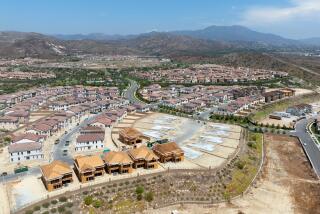Developers Should Pay Up
- Share via
Riverside County didn’t invent the developer fee. But its refusal to quail when builders screamed is thrusting the county into a lonely category: municipalities that are finally placing long-term planning ahead of short-lived benefits.
Orange County should pay heed to its neighbor’s newfound toughness and learn two important lessons. County residents have for too long subsidized builders’ profits by bearing the strains on roads, the environment, schools and the like. And every developer isn’t going to stop building -- or go out of business -- if it has to start bearing more of the actual cost of their projects.
Riverside County slapped a $6,650 flat fee this month onto each new home to fund roads in the car-clogged region. Cities that don’t follow suit might be locked out of the county’s half-cent sales tax for transportation.
Riverside officials haven’t always been such planning mavens. Houses, stores and industry have sprouted like haphazard weeds after a good rain. Two-thirds of county residents live at least 10 miles from a central business district, which means busy gas stations line the long route from home to job to shopping. Residents are screaming for relief, something they have time to do as they inch forward on freeways at speeds any reasonably fit tortoise could outpace.
Developers responded to the impending fee with predictable howls. It would push housing prices beyond reach, they moaned, having suddenly turned into affordable-housing activists. The county would see them in court, they vowed. But the county held the ultimate card, the threat of a building moratorium, and developers backed off.
With its focus on traffic, the fee attacks only the most obvious and economically stifling result of hyperdevelopment. Planners in Riverside County and throughout most of Southern California for decades have conveniently ignored the true costs of massive housing construction. New-home owners generally pay long-term assessments for roads and sewers, sometimes even for school campuses. Less attention goes to the runoff that pollutes a local stream trickling its way 40 miles or more to the ocean, jammed airport parking lots and the local community college that can’t provide even existing students with the courses they need to move on to four-year school.
Instead, housing projects are approved based on the sketchiest notion of their expected impact. Developers take their hefty profits, and, years down the road, residents old and new are left to bewail failing roads, bacteria-laden coastal waters and the five or six years it takes to complete a bachelor’s degree at a public university. The region stumbles toward decrepitude.
Riverside County’s fee has opened the door to reviewing development in a realistic light. Planners, politicians and the public must assess the full costs of development and account for how those costs will be paid -- through some combination of builder fees, housing assessments and taxes. That might nudge the housing industry toward renovation of blighted urban areas, where those long-term costs are far smaller.
Once everyone faces the true price of suburban sprawl, it looks even less attractive than it sounds.


